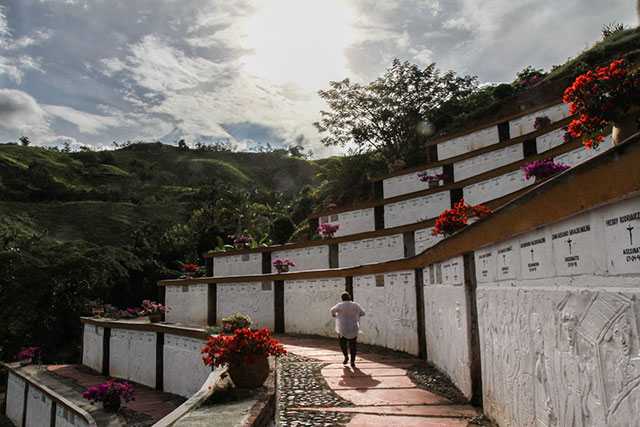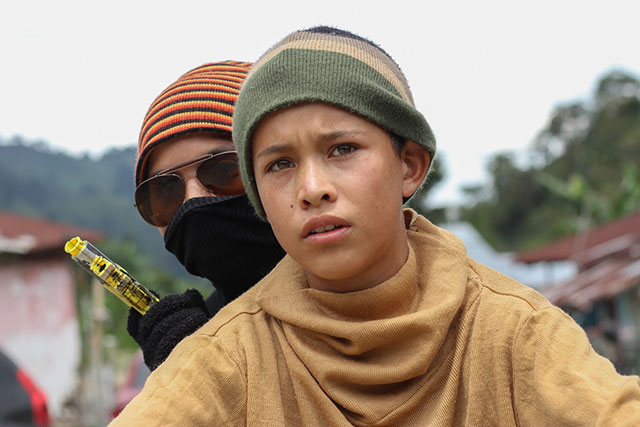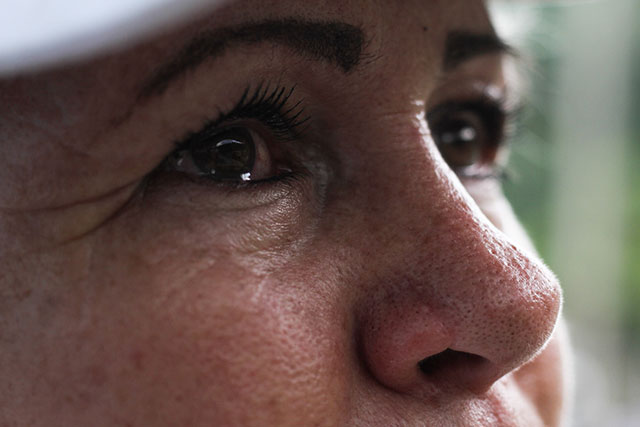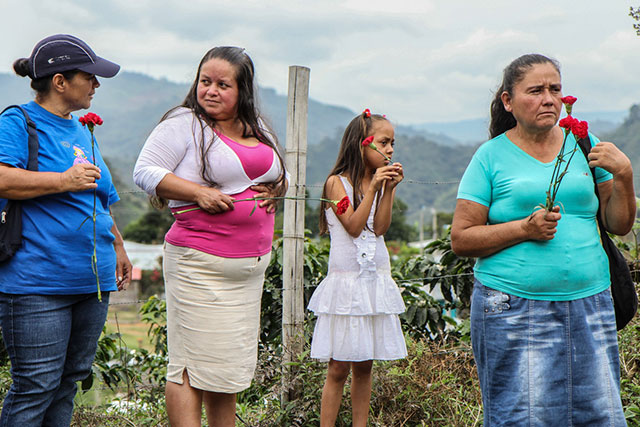
The town of Trujillo in southwestern Colombia overflows with lush beauty. On its steep green hillsides hang banana plants, coffee bushes and picturesque trees with white flowers. Behind this beauty, however, lies a historic tragedy in which over 300 campesino farmers were massacred between 1989 and 1992, with the majority of people killed during March and April of 1990.
“It’s a very difficult and ugly experience that no family should ever have to live through.”
Neither the prospect of a peace accord being brokered in Havana, Cuba, between guerrillas from the Revolutionary Armed Forces of Colombia (FARC) and the Colombian government, nor the prospect of a future agreement with guerrillas from the National Liberation Army (ELN) has given these residents hope. The majority of the violence that they suffered was at the hands of drug trafficking paramilitary groups working in cahoots with the army and police. Paramilitaries still reign throughout Colombia, even though they were formally demobilized in the mid-2000s. Various campesinos have been threatened and murdered by these groups in Valle de Cauca State where Trujillo is located. Residents also say they have seen too many failed peace agreements to truly believe that the guerillas will cease to operate.
What does give residents hope, 25 years after terror reigned in their community, is their ability to reconstruct their communities’ social fabric, activate agricultural productivity and also receive compensation from the Colombian government as they are officially recognized as victims of the armed conflict.
Since 1996, the Inter-American Court of Human Rights has been examining the case, and on April 6, 2016, the court ordered the Colombian government to acknowledge the role it played in the massacre. The government has agreed to do so this Saturday, April 23, in the Trujillo Memorial Park.
The court’s ruling also obliges the government to try those responsible for these acts of violence. Currently only one paramilitary leader — Henry Loaiza, who is known as el Alacrán (“the Scorpion”) — is behind bars. Many residents still don’t know who is responsible for the murders of their loved ones.
Living in Fear
 The Trujillo Monument Park is dedicated to preserving collective memory and honoring those massacred. (Photo: Andalusia Knoll)
The Trujillo Monument Park is dedicated to preserving collective memory and honoring those massacred. (Photo: Andalusia Knoll)
Maria Elena Correa Acosta is one of them. Her grandparents helped establish the community of La Sonora in Trujillo, and she and her husband, German Martinez, grew up there and harvested coffee. On April 31, 1990, Martinez didn’t return home and given the extreme level of violence their community was experiencing, she feared the worst. The following morning fellow coffee workers arrived at her home to let her know that her husband’s dead body was found stretched out on the dirt highway leading to town.
He had met a better fate than dozens of other residents from Trujillo, whose bodies were dismembered and tossed into the local Cauca River. Other people’s bodies were never found and are still considered “disappeared” to this date.
“While the government is negotiating peace, we will be constructing it from below with our nails and hunger.”
With a 2-year-old daughter and no safety net, Correa kept cultivating coffee on their family farm until, two weeks later, neighbors told her that armed men were occupying her property and she was their next target. “I grabbed some clothes and my baby, went to the road, and I ran, I ran I ran,” Correa said. She went to the nearby city of Cali and made ends meet by cooking, washing clothes and working other random jobs.
One day she decided to defy her displacement, a fate that 6 million other Colombians share, and returned to live in Trujillo. She convinced a government entity to allow her to work paving roads, even though they previously only employed men. Little by little she was able to reconstruct her life, although threats of violence persisted in Trujillo.
She now participates regularly in activities to commemorate the massacre and keep historical memory alive. “It’s very difficult to remember all this. It’s a very difficult and ugly experience that no family should ever have to live through,” Correa told Truthout.
Memorializing the Dead
 Middle school students in La Sonora, Trujillo, performed a theater piece about the violence their community suffered before they were born. (Photo: Andalusia Knoll)
Middle school students in La Sonora, Trujillo, performed a theater piece about the violence their community suffered before they were born. (Photo: Andalusia Knoll)
Even though they lived in a constant climate of fear, the people of Trujillo never remained silent. In the late 1980s, Father Tiberio Fernandéz was accused of being a guerilla because he had aided local campesino organizations, and documented all incidents of violence in the area. “If my blood can help Trujillo reach a new dawn where the peace that we so desperately need flowers, I will gladly let it be spilled,” said Fernandéz days before armed men kidnapped him. His corpse, dismembered by a chainsaw, was found in the Cauca River days later.
Today, his remains rest on a hillside in Trujillo as part of the Historical Memory Museum. On the green hillsides, murals intertwine with tombs that often don’t contain bodies but instead contain special possessions like wedding dresses and photos. The museum was founded by the Association for Victims of Trujillo (AFAVIT), which has spent the last 20 years honoring those killed and disappeared and demanding justice for those responsible. Various members of the organization have also been threatened and murdered in this fight for justice.
A report on Trujillo issued by the Historical Memory Team, titled “Trujillo, a Tragedy That Never Ends,” said the monument is a cosmogony of suffering. “Trujillo is perhaps one of the most symbolic examples of the greatest cultural creativity in Colombia, generated in this process of confronting the violence,” according to the report. Artists have partnered with AFAVIT to construct rafts with enormous portraits of the people whose remains were dumped in the Cauca River, and their relatives have floated down the river accompanying these symbolic pieces of art.
Government Efforts at Restitution
 Maria Elena Correa’s husband was murdered in the massacre. Speaking about him still brings her to tears. (Photo: Andalusia Knoll)
Maria Elena Correa’s husband was murdered in the massacre. Speaking about him still brings her to tears. (Photo: Andalusia Knoll)
In recent years the state has been stepping in and attempting to play the same role that many victims civic organizations did before. In 2011, Juan Manuel Santos, the president of Colombia, signed the Law of Victims and Land Restitution and has dedicated more resources to helping heal wounds in communities like Trujillo. This law grants “rights to damages, restitution of prior living conditions, and a range of social services for all victims,” including those who have been disappeared, murdered or displaced, or who have suffered other serious violations of human rights.
The Victims Unit was established and hundreds of people from that unit have been deployed to communities like Trujillo to assess their needs and help them access resources and justice. “Since 2013 we have been coming here to help them reconstruct the social fabric, establish the existence of government institutions and allow them to enjoy the rights they are guaranteed,” said Juliana Mejia, who works with the unit.
Mejia, along with other members of the unit, helped the community realize a commemorative act on April 10, 2016, as part of the National Victims’ Day, which was created as part of the recent victims’ law.
Over 100 people walked through the lush hillsides of Trujillo with red carnations in hand and banners begging people to “never forget.” Local middle school students held a theater performance during which they reenacted the scenes of terror that happened before they were born.
The commemorative act was officiated by resident Juan Bautista, who had various family members disappeared and allegedly dismembered on April 1, 1990. “They have taught us to defend our human rights,” said Bautista, who was skeptical of the federal government’s commitment to peace but did rest his trust in the Victims Unit.
“They are putting aside their fears and working together so they can have impulse projects together,” said Mejia about the progress she has witnessed over the years. “Neighbors and some family members didn’t even speak to each before because of all the mistrust generated by the armed groups in the area.”
Displaced People Recuperate Land Through Cooperatives
 Residents in Trujillo prepare for a march to commemorate the more than 300 people who were massacred in their community during a few bloody years of Colombia’s armed conflict. (Photo: Andalusia Knoll)
Residents in Trujillo prepare for a march to commemorate the more than 300 people who were massacred in their community during a few bloody years of Colombia’s armed conflict. (Photo: Andalusia Knoll)
The Victims Law also dictated that Colombia’s millions of displaced people have a way to return to their land. Some of Trujillo’s residents are among the 3.4 percent of people who have successfully recuperated their land since the law was enacted. Millions of others have had greater difficulties returning to their land due to bureaucracy and also the lack of security in their regions.
Correa says they have formed a new cooperative and are looking for new distribution methods for the coffee and bananas that they grow in La Sonora. One of the great difficulties for small farmers returning to the rural communities that they had fled during the conflict is the lack of infrastructure and roads to distribute their crops.
La Sonora is a 45-minute drive on a dirt road from the center of Trujillo, which itself is fairly isolated. “It’s important for us to do this collectively so we can have a place to sell as part of a group association,” Correa said.
While she is hopeful about her own future as a campesina, she is concerned about her daughter’s future. Her daughter, who was only 2 when her father was murdered, now aspires to be a lawyer but had to drop out of the university for lack of funds. She has continually been promised humanitarian aid, which she says never comes.
“We know that they will never return our loved ones, but at least a little help so that my daughter can keep studying law,” Correa said. “We have to put up resistance so we can keep cultivating food and [so] that they don’t trample on us as the government has previously abandoned us,” she added.
This Saturday, when the Colombian government holds its event in the Trujillo Memorial Park to formally recognize its involvement in the massacre, could perhaps signal a new era in the government’s treatment of families who have suffered violence: The victims have also been promised financial compensation. A key element of the ruling from the Inter-American Court of Human Rights and also of the Victims Law is a demand that this violence not be repeated, which can only be achieved if impunity is eliminated.
“The fact that the cases are not brought to justice and that the truth doesn’t emerge helps maintain the wound that the victims face,” said Peter Drury, a researcher on Colombia with Amnesty International. “If members of armed forces, guerillas or paramilitaries receive the message that they will not be prosecuted, there is no incentive to prevent them from not repeating the crimes,” said Drury, relating the current peace process to Trujillo’s dark history.
“While the government is negotiating peace,” Bautista said, “we will be constructing it from below with our nails and hunger.”
Note: This article was made possible with the support of the IWMF Adelante Fellowship.
Join us in defending the truth before it’s too late
The future of independent journalism is uncertain, and the consequences of losing it are too grave to ignore. To ensure Truthout remains safe, strong, and free, we need to raise $34,000 in the next 72 hours. Every dollar raised goes directly toward the costs of producing news you can trust.
Please give what you can — because by supporting us with a tax-deductible donation, you’re not just preserving a source of news, you’re helping to safeguard what’s left of our democracy.